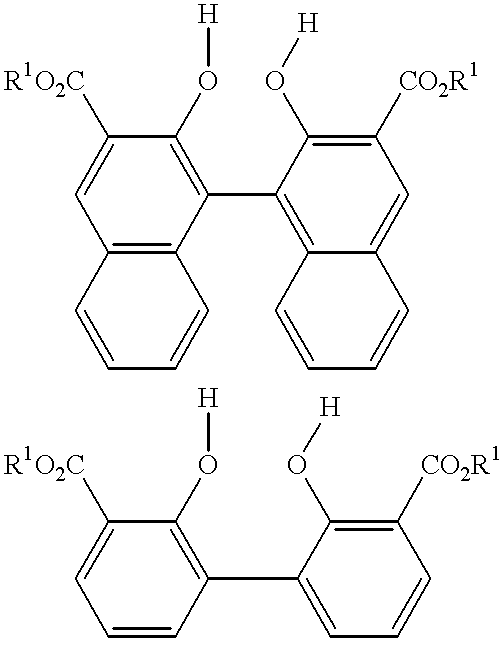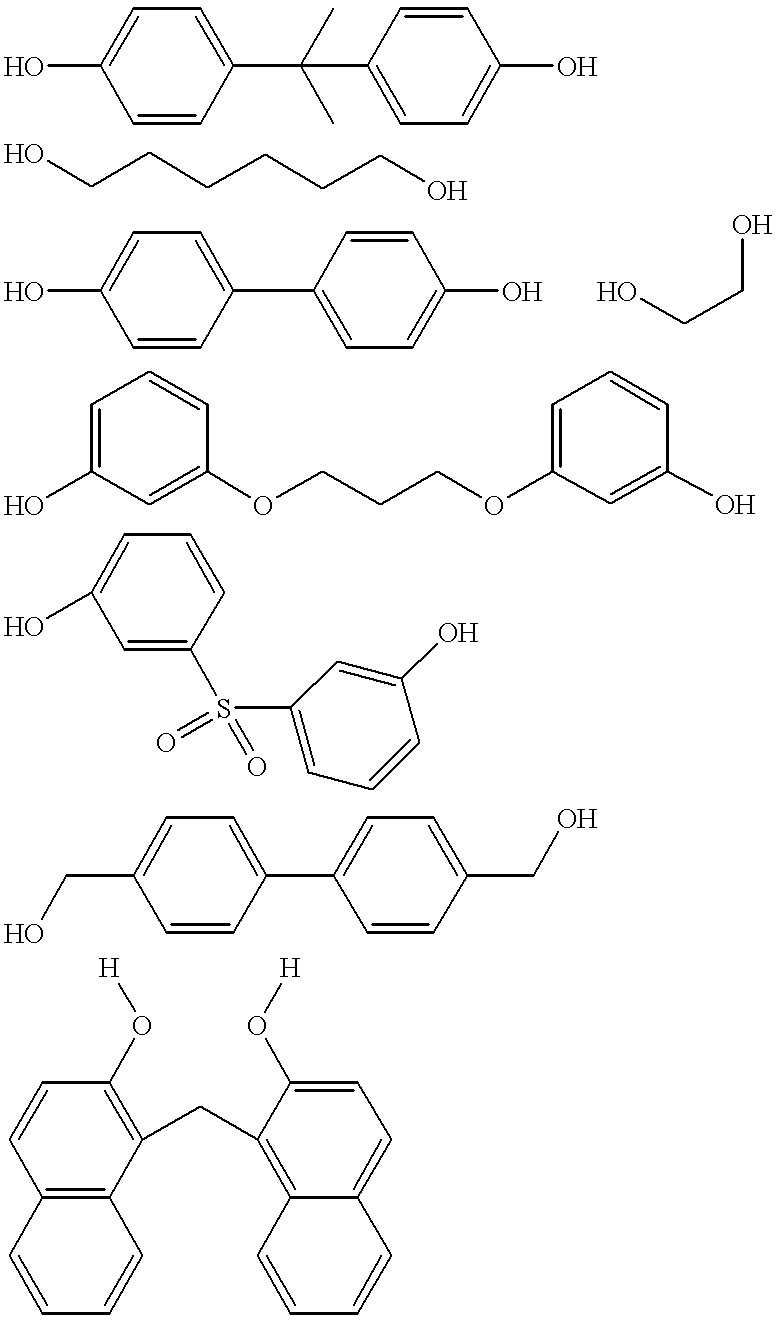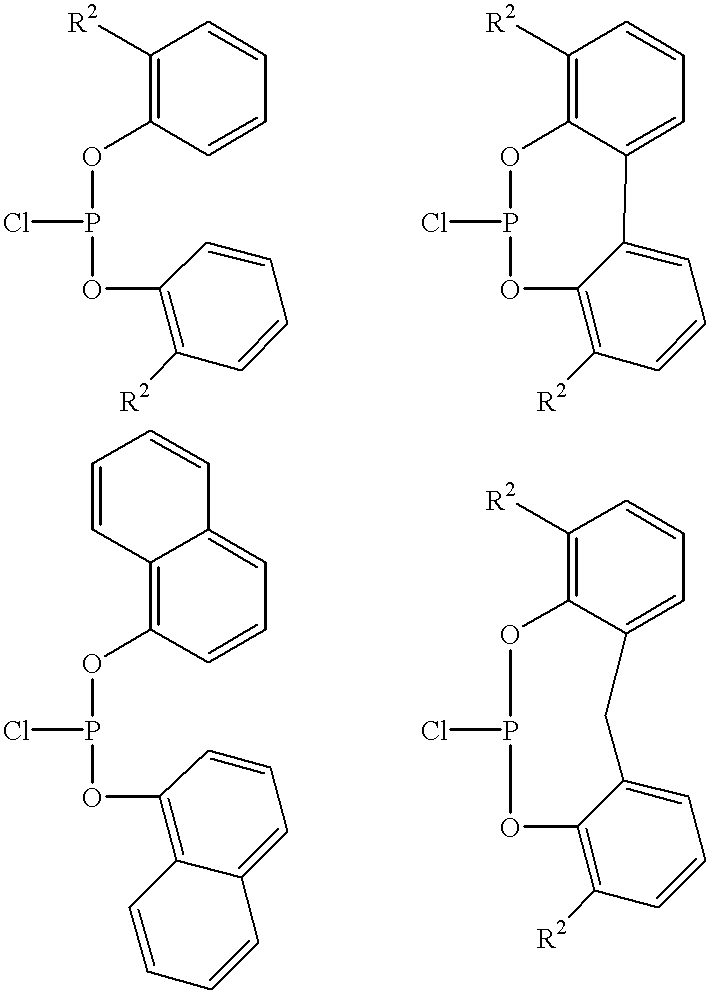Polymeric phosphite composition and hydrocyanation of unsaturated organic compounds and the isomerization of unsaturated nitriles
a technology of unsaturated organic compounds and polymeric phosphite, which is applied in the direction of organic compounds/hydrides/coordination complexes, physical/chemical process catalysts, chemical instruments and processes, etc., can solve the problems of difficult quantitative recovery of catalysts and ligands, loss of catalyst into the product phase, thermal degradation of catalysts, etc., and achieve the effect of controlling the solubility of composition
- Summary
- Abstract
- Description
- Claims
- Application Information
AI Technical Summary
Benefits of technology
Problems solved by technology
Method used
Image
Examples
first embodiment
The polymeric phosphite compositions disclosed in the invention are also referred to as ligands in the application. According to the invention, composition A comprises, consist essentially of, or consist of repeat units derived from (1) a carbonyl compound, (2) a monomer, and (3) phosphorchloridite.
The carbonyl compound has the formula of (R1O2C)m(OH)—Ar1—(OH)(CO2R1)m, (R1O2C)m(OH)—Ar2—A2—Ar2—(OH)(CO2R1)m, (R1O2C)m(OH)—Ar2—Ar2—(OH)(CO2R1)m, and combinations of two or more thereof.
The monomer is selected from the group consisting of a first polyhydric alcohol, a diamine, a triamine, a tetraamine, and combinations thereof.
The term “polyhydric alcohol” used herein refers to, unless otherwise indicated, a molecule having two or more hydroxyl groups. Generally a polyhydric alcohol can be selected from the group consisting of dialcohols, trialcohols, tetraalcohols, and combinations of two or more thereof.
The first polyhydric alcohol has the formula selected from the group consisting of (H...
fourth embodiment
According to the invention, composition B is produced by a process which comprises (1) contacting phosphorus trichloride with a second polyhydric alcohol under a condition sufficient to produce a phosphorus-containing polymer and (2) contacting the phosphorus-containing polymer with an aromatic diol.
The definition and scope of the second polyhydric alcohol and aromatic diol are the same as those disclosed above.
In the first step of the process, a phosphorus-containing polymer (a polumeric phosphorochloridite) with P—Cl bonds is prepared. The polymer containing phosphorochloridite can be prepared by treating one molar equivalent of PCl3 with about two molar equivalents of reactive hydroxy group of the second polyhydric alcohol in the absence of an organic base. The resulting solution is then treated with at least two equivalents of an organic base to produce a polymer containing phosphorochloridite. Suitable bases are organic amines. Especially preferred are trialkylamines. The most ...
fifth embodiment
According to the invention, the phosphorus-containing polymer can be alternatively produced by contacting an N,N-dialkyl dichlorophosphoramidite with the second polyhydric alcohol to produce a polymeric phosphoramidite followed by contacting the polymeric phosphoramidite with an acid such as, for example, hydrochloric acid to produce the phosphorus-cotaining polymer such as, for example,polymeric phosphorochloridite. Generally any N,N-dialkyl dichlorophosphoramidite known to one skilled in the art can be used. Each of the alkyl group can contain 1 to about 20, preferably 1 to about 10 carbon atoms.
According to the fourth or fifth embodiment of the invention, the molecular weight of the phosphorus-containing polymer can be modified by further contact with an aromatic diol that will react with unreacted P—Cl bonds. The contacting of the phosphorus-containing polymer with the aromatic diol can be carried out under a condition sufficient to produce a polymer containing a phosphite group...
PUM
| Property | Measurement | Unit |
|---|---|---|
| Angle | aaaaa | aaaaa |
Abstract
Description
Claims
Application Information
 Login to View More
Login to View More - R&D
- Intellectual Property
- Life Sciences
- Materials
- Tech Scout
- Unparalleled Data Quality
- Higher Quality Content
- 60% Fewer Hallucinations
Browse by: Latest US Patents, China's latest patents, Technical Efficacy Thesaurus, Application Domain, Technology Topic, Popular Technical Reports.
© 2025 PatSnap. All rights reserved.Legal|Privacy policy|Modern Slavery Act Transparency Statement|Sitemap|About US| Contact US: help@patsnap.com



